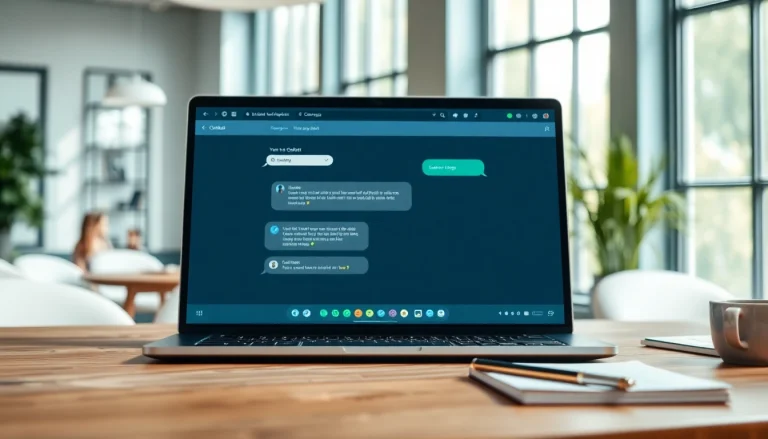
Understanding AI Chatbots for Websites
What is an AI Chatbot?
An AI chatbot is a software application designed to simulate human conversation through text, voice, or both. Using natural language processing (NLP) and machine learning, AI chatbots can interpret user inquiries and respond appropriately, driving engagement on websites and improving customer interactions.
These tools have become increasingly essential as businesses shift towards digital solutions for customer service. An AI chatbot for website acts as a virtual assistant that can handle numerous inquiries simultaneously, providing timely support and enhancing user experience.
Benefits of AI Chatbots in Customer Service
The implementation of AI chatbots offers substantial benefits, including:
- 24/7 Availability: Unlike human agents, chatbots can provide customer assistance around the clock, ensuring customers receive help whenever they need it.
- Cost Efficiency: By automating responses to frequently asked questions and simple requests, businesses can reduce staffing costs associated with customer service.
- Consistency: Chatbots provide standardized answers, minimizing discrepancies and ensuring that all customers receive the same quality of information.
- Scalability: AI chatbots can handle multiple conversations simultaneously, enabling businesses to scale their customer service efforts without a proportional increase in costs.
- Data Collection: Chatbots can gather insights from user interactions, helping companies understand customer behavior and preferences.
Common Use Cases for AI Chatbots
AI chatbots have a wide range of applications across different industries, including:
- E-commerce: Assisting customers with product information, order tracking, and returns.
- Healthcare: Scheduling appointments, answering patient inquiries, and providing pre-care advice.
- Banking: Handling account inquiries, transaction requests, and providing financial advice.
- Travel: Assisting with booking tickets, providing travel updates, and answering destination-related questions.
- Education: Answering admission queries, providing course information, and assisting with enrollment processes.
How to Choose the Right AI Chatbot for Your Website
Key Features to Consider
Choosing the right AI chatbot involves evaluating several key features:
- Natural Language Processing: Ensure the chatbot can comprehend and respond to user inputs effectively.
- Customization: The ability to tailor the chatbot’s responses, appearance, and behavior to align with your brand.
- Integration: Look for chatbots that can integrate seamlessly with existing systems such as CRM tools, email platforms, and e-commerce solutions.
- Analytics: A good chatbot should provide insights and reporting tools to assess performance and user engagement.
- Multi-Platform Support: The chatbot’s compatibility with various platforms, including websites, mobile apps, and social media channels, is essential for comprehensive reach.
Budgeting for Chatbot Implementation
Implementing an AI chatbot involves various costs that should be taken into account:
- Development Costs: Depending on whether you choose an off-the-shelf solution or a custom development, costs can vary significantly.
- Maintenance Expenses: Regular updates, bug fixes, and enhancements will incur ongoing expenses.
- Hosting Fees: On some platforms, hosting your chatbot may lead to additional costs based on usage.
- Training Resources: Preparing your chatbot requires time and resources, especially if extensive NLP training is needed.
Identifying Your Business Needs
Before implementing an AI chatbot, it is crucial to understand your specific business needs. Consider factors such as:
- Customer Volume: Evaluate the number of customer interactions you typically experience.
- Nature of Inquiries: Analyze the most common questions or issues customers raise.
- Desired Outcomes: Define what success looks like for your chatbot (e.g., reducing response time, increasing user satisfaction).
Implementing an AI Chatbot Successfully
Step-by-Step Integration Process
Implementing an AI chatbot can be broken down into several essential steps:
- Define Objectives: Clearly outline what you want your chatbot to achieve.
- Select a Platform: Choose a chatbot platform based on your feature requirements and budget.
- Develop the Chatbot: Work with developers or use built-in tools to create your chatbot’s framework.
- Integrate with Existing Systems: Ensure your chatbot integrates well with your CRM, websites, and other tools.
- Test the Bot: Conduct extensive testing to ensure the chatbot functions as intended.
- Launch: Roll out the chatbot to your website and monitor initial interactions.
Testing and Optimization Strategies
To ensure your chatbot meets customer expectations, regular testing and optimization are necessary:
- User Feedback: Encourage users to provide insights on their experiences with the bot.
- A/B Testing: Experiment with varying responses or interfaces to see what resonates best with users.
- Performance Metrics: Monitor key performance indicators (KPIs) to assess the bot’s effectiveness.
Training Your Chatbot for Maximum Effectiveness
Training your AI chatbot is crucial for its success. Consider the following strategies:
- Real Chat Transcripts: Utilize historical chat records to teach the chatbot how to handle various inquiries.
- Continuous Learning: Implement machine learning techniques that allow the chatbot to learn from interactions over time.
- Human Oversight: Have staff oversee conversations and intervene when necessary to ensure accurate responses.
Measuring the Success of Your AI Chatbot
Key Performance Indicators to Track
Monitoring the success of your AI chatbot involves tracking several key performance indicators (KPIs):
- Response Time: Measure how quickly the bot responds to user inquiries.
- User Satisfaction: Utilize surveys or feedback forms to gauge user sentiment.
- Conversion Rate: Track how many interactions lead to desired outcomes (e.g., sales, sign-ups).
- Engagement Rate: Evaluate how often users are interacting with the chatbot.
Tools for Measuring Engagement and Conversion
Several tools can help assess chatbot performance and user engagement:
- Google Analytics: Set up goal tracking for engagements and conversions driven by the chatbot.
- Chatbot Analytics Platforms: Utilize platforms specifically designed for chatbot performance analysis.
- User Satisfaction Surveys: Collect direct feedback through surveys to assess user satisfaction.
Adjusting Strategies Based on Data Insights
The data collected from your AI chatbot can provide valuable insights for strategy refinement:
- Identifying Knowledge Gaps: Analyze frequent questions that go unanswered and update the chatbot’s knowledge base accordingly.
- Improving User Interface: Use feedback to enhance the user interface for a smoother experience.
- Dynamic Response Adjustments: Tailor responses based on user sentiment analysis collected from interactions.
Future Trends in AI Chatbots for Websites
Personalization and User Experience Enhancements
The future of AI chatbots lies in personalization. Users expect tailored interactions based on their preferences and past behavior. Advancements in AI technology will facilitate increasingly personalized experiences, making chats more relevant and engaging.
Integrating user profiles, behavior tracking, and predictive analytics will enable chatbots to provide individual recommendations and tailored support, ultimately enhancing user satisfaction and loyalty.
Integrating AI with Other Technologies
As technology evolves, the integration of AI chatbots with other digital tools like augmented reality (AR), virtual reality (VR), and voice assistants will offer unprecedented opportunities for enriched interaction:
- AR and VR: These technologies can provide immersive experiences, with chatbots guiding users throughout.
- Voice Integration: Integrating chatbots with voice recognition will enable voice-activated assistance across devices.
The Evolving Role of Chatbots in Business
As AI chatbots become more sophisticated, their role in business is set to evolve significantly. Here are some future possibilities:
- Advanced Emotion Recognition: Future chatbots may be able to detect user emotions and adjust responses accordingly.
- Greater Autonomy: With enhanced AI, chatbots may autonomously manage complex queries without human intervention.
- Strategic Decision Making: AI systems could analyze data trends and assist in strategic decision-making processes.





